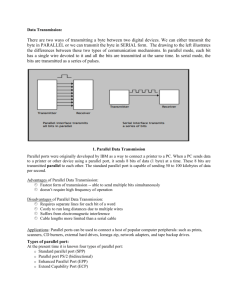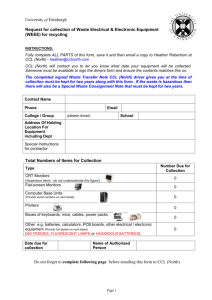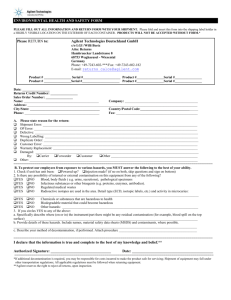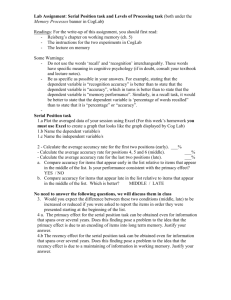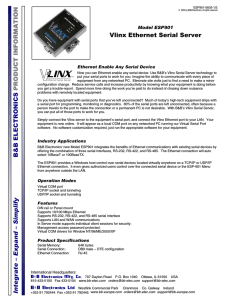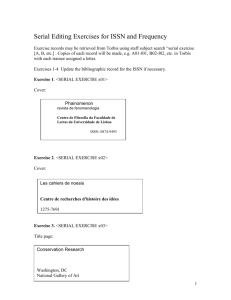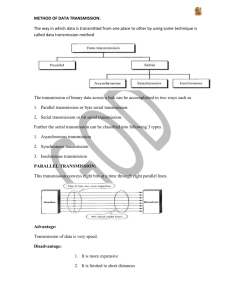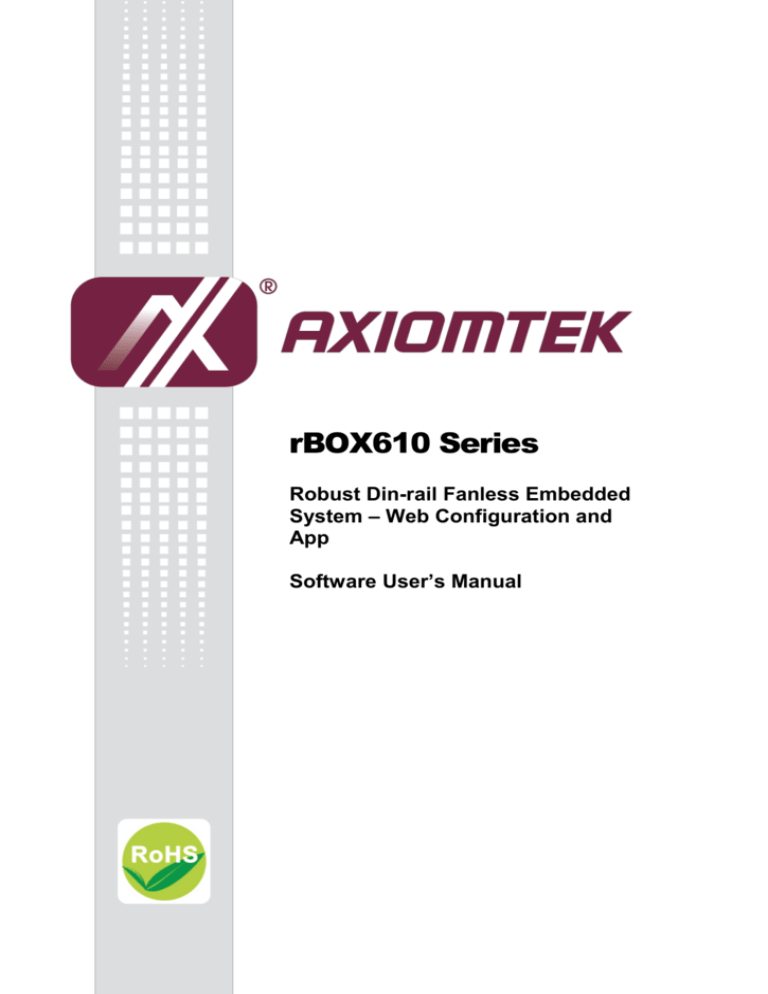
rBOX610 Series
Robust Din-rail Fanless Embedded
System – Web Configuration and
App
Software User’s Manual
Disclaimers
This manual has been carefully checked and believed to contain accurate information.
Axiomtek Co., Ltd. assumes no responsibility for any infringements of patents or any third
party’s rights, and any liability arising from such use.
Axiomtek does not warrant or assume any legal liability or responsibility for the accuracy,
completeness or usefulness of any information in this document. Axiomtek does not make any
commitment to update the information in this manual.
Axiomtek reserves the right to change or revise this document and/or product at any time
without notice.
No part of this document may be reproduced, stored in a retrieval system, or transmitted, in
any form or by any means, electronic, mechanical, photocopying, recording, or otherwise,
without the prior written permission of Axiomtek Co., Ltd.
Trademarks Acknowledgments
Axiomtek is a trademark of Axiomtek Co., Ltd.
®
Windows is a trademark of Microsoft Corporation.
Other brand names and trademarks are the properties and registered brands of their
respective owners.
Copyright 2014 Axiomtek Co., Ltd.
All Rights Reserved
April 2014, Version A2
Printed in Taiwan
ii
Table of Contents
Disclaimers ..................................................................................................... ii
Chapter 1
1.1
Introduction ............................................. 1
Specifications ...................................................................................... 2
Chapter 2
Getting Started ....................................... 5
2.1
Install the Application ......................................................................... 5
2.2
Uninstall the Application .................................................................... 6
Chapter 3
Application Software .............................. 7
3.1
Web Configuration .............................................................................. 7
3.2
3G App ............................................................................................... 20
3.3
GPS App ............................................................................................. 21
3.4
Serial Server App .............................................................................. 23
3.4.1
3.4.2
3.4.3
3.4.4
3.4.5
3.5
Virtual Com Mode Setting ......................................................................... 25
Pair Connection ......................................................................................... 28
TCP Server Setting ................................................................................... 31
TCP Client Setting ..................................................................................... 34
UDP Setting ............................................................................................... 38
Modbus Gateway App ....................................................................... 41
3.5.1
3.5.2
LAN Port .................................................................................................... 42
Serial Port .................................................................................................. 48
iii
This page is intentionally left blank.
iv
rBOX610 Web Configuration and App
Chapter 1
Introduction
The rBOX610 comes with a set of application software providing functionalities like Serial
Server, Modbus Gateway, 3G Configuration, GPS Configuration, DIO Configuration, SNMP,
Alarm, and etc. Users also can download this package from website given below and install it
on rBOX610.
http://www.axiomtek.com/Download/Download/rBOX610/rBOX610AP-2.2.2.tar.gz
Software Structure
The rBOX610 comes with a set of application software including Serial Server App, Modbus
Gateway App, 3G App, GPS App, and Apps for DIO Configuration, SNMP, Alarm, and etc.
Through web browser, user can communicate with Web Server App for configuring Apps like
Serial Server App, Modbus Gateway App, 3G App and etc. After set up, setting values are
stored in a configuration file which is simultaneously used by Web Server App and other Apps.
Some data are stored in EEPROM, which will be read by some Apps when being executed. To
ensure normal functioning of the Apps, it is strongly recommended that you should avoid
modifying these data.
Introduction
1
rBOX610 Web Configuration and App
1.1
Specifications
OS: Linux
Kernel: 2.6.35.3 (with Freescale and Axiomtek hardware modified patch)
Support Protocol Types
ICMP
TCP/IP
UDP, DHCP, Telnet, SNMP, HTTP, HTTPS, SSL, SMTP, ARP, NTP, DNS, PPP,
PPPoE, FTP, TFTP
Protocol in Details
SNMP
- Support V1/V2C/V3
- Support SNMP Private MIB
- Support read/write
HTTP/ HTPPS
- Support SSL
- Support configuration Import/ Export
Support Software Types (Developed by Axiomtek)
Serial Server
- Support TCP Server/ TCP Client/ UDP/ Pair/ VC
- Support IP filter
- Support 32 TCP connections
- Support QoS
Modbus Gateway
- Support Modbus TCP/ Modbus RTU/ Modbus ASCII
- Support IP filter
- Support 32 connections
- Support TCP for multiple comport
- Support QoS
3G
- Support user name/password
- Detect signal strength
GPS
- Detect signal strength
- Support satellite positioning
Support Functionalities
Remote Manager
- Remote log (coming soon)
- Email
- SNMP
- Support Trap
®
Serial Port Redirector for Windows
®
®
®
- Windows XP/ Windows 2003 (32-bit, 64-bit)/ Windows 7 (32-bit, 64-bit)/
®
®
Windows Vista (32-bit, 64-bit)/ Windows 2008 (32-bit, 64-bit)
- Real com (visual com)
- Centralized management
- Import/ Export for real com
Default Reading
- Support default reading for MAC, IP and Model No
2
Introduction
rBOX610 Web Configuration and App
Support Hardware I/O
Digital I/O
- Read digital input
- Write digital output
COM
- RS-232/422/485 mode setting
All specifications and images are subject to change without notice.
Note
Introduction
3
rBOX610 Web Configuration and App
This page is intentionally left blank.
4
Introduction
rBOX610 Web Configuration and App
Chapter 2
Getting Started
2.1
Install the Application
Follow steps below to install the application package on rBOX610.
1.
Download rBOX610AP-2.2.2.tar.gz.
2.
To extract the compressed file.
®
For Windows users, you may use the WinRAR compression software utility.
For Linux users, extract the source tar ball with the following command:
$ tar zxf rBOX610AP-2.2.2.tar.gz
3.
Now you can see the following 3 files:
rBOX610AP: Application package installation program.
uninstall.sh: A script file for uninstalling application package.
readme: A readme file.
4.
Copy rBOX610AP and uninstall.sh to USB flash drive.
5.
Boot up the rBOX610 and mount USB flash drive.
$ mkdir -p /mnt/usb
$ mount /dev/sda1 /mnt/usb
$ cp /mnt/usb/rBOX610AP /root
$ cp /mnt/usb/uninstall.sh /root
Install the application.
$ cd /root
$ ./rBOX610AP
If you see the message ‘Install success’, then please reboot rBOX610.
$ reboot
Getting Started
5
rBOX610 Web Configuration and App
6.
After successful installation, the App LAN1 default IP address is 192.168.0.254 and
LAN2 default IP address is 192.168.10.1. Open a web browser and key in the IP address
into web browser’s address bar. Then you can see the following web.config page
displayed.
Please enter the default password “admin” when you login the web configuration page under
Web App.
2.2
Uninstall the Application
Follow steps below to uninstall the application package from rBOX610.
1.
Execute uninstall.sh to uninstall the application.
$ cd /root
$ sh uninstall.sh
2.
Reboot rBOX610.
$ reboot
6
Getting Started
rBOX610 Web Configuration and App
Chapter 3
Application Software
3.1
Web Configuration
Web Server App not only acts as Web portal from where user can configure Apps like Serial
Server, Modbus Gateway, 3G, GPS, but also provides functionalities for configuring system
time, alert by email or SNMP trap, enabling digital input/output, changing password, restoring
factory default configuration, configuration file import/export and restarting system.
Follow instructions below for web configuration.
1.
Login the rBOX610.
2.
Open a web browser and key in the IP address: 192.168.0.254, into web browser’s
address bar. Then you can see the following web-based login page displayed.
3.
Enter the factory default password: admin.
4.
Then click the “Submit” button to login to the overview manual.
Application Software
7
rBOX610 Web Configuration and App
Overview Menu:
This system overview window gives the general information on rBOX610.
Protocol Mode:
There are 3 protocol modes: None, Serial Server and Modbus; which stands for 3 different
controlling Apps. If None mode is selected, Web Server App takes control, all four COM
ports are disabled (not used by application) which means users are allowed to develop
COM port related programs, and the overall menu keep unchanged.
If Serial Server mode is selected, the controlling App is Serial Server App, and the
following menu items change in accordance to allow applicable configuration. If Modbus
mode is selected, the controlling App is Modbus Gateway App, and the following menu
items change in accordance to allow applicable configuration.
8
Application Software
rBOX610 Web Configuration and App
In None Mode: Web Server App takes control.
Choose None from the “Protocol Mode” drop-down list. Click “Submit” button when you
have finished setting protocol mode.
Basic Network:
In Basic Network Settings page, users are allowed to edit Network Settings and Time
Settings.
IP configuration
Click “IP configuration” drop-down menu to choose Static or DHCP from the drop-down
list. User can manually assigns (if Static is selected) or DHCP server automatically
supplies (if DHCP is selected) an IP address, gateway address and subnet mask to
Modbus Gateway.
Application Software
9
rBOX610 Web Configuration and App
IP address
Click in “IP address” text box and type a new address to change the IP address.
Netmask
Click in “Netmask” text box and type a new address to change the Netmask.
Gateway
Click in “Gateway” text box and type a new address to change the Gateway.
DNS server 1, 2, 3
Click in “DNS server 1”, “DNS server 2” or “DNS server 3” text box and fill in DNS
information.
System Time:
Time zone (24-hour)
Click “Time zone” drop-down menu to select a different time zone from the drop-down list.
Local time
Click in “Local time” text box to set date and time .
Time server
Click in “Time server” text box to enter time server address. Check this option to enable
time server.
10
Application Software
rBOX610 Web Configuration and App
Alarm Type:
If “Trap” or “Email” is checked, when event occurs the alarm message will be sent out by
email or SNMP trap respectively.
Message
Event
Log-in password error
Login with wrong password.
Password has been reset
Change password.
IP has been modified
Change IP address (should plug power off and on).
Serial port status change
System has warm-started
Change serial port or mode configuration.
Accessible IP status change
Device has warm-started
Access Control List changed.
Device has warm-started
Port restart.
Serial port status change
Device has warm-started
Change serial port or mode configuration.
Reset to Default
(keep networking settings)
Restore factory defaults (keep networking settings).
Reset to Default
Restore factory defaults (all).
Device has started
System has cold-started
Power plug on.
DI(DO) NO. status – High(Low)
DIO status changed.
Interface(eth0,ppp0…) status – Link
up(down)
Network interface link up or link down.
Application Software
11
rBOX610 Web Configuration and App
Email Alert:
SMTP Host
Click in “SMTP Host” text box and enter IP address of the SMTP (Simple Mail Transfer
Protocol) host.
SMTP Port
Click in “SMTP Port” text box and enter the SMTP port number. The default SMTP port
number is 25.
Login ID
Login the account of SMTP.
Password
Login the password for SMTP.
Sender
Sender’s name.
Sender Email address
Sender’s mailbox.
E-mail address 1~4
Click in “E-mail address 1~4” text box and specify email addresses for receiving emails.
Use this option to enable email address 1~4 by checking the “Enable” box.
12
Application Software
rBOX610 Web Configuration and App
SNMP Trap:
This option is for IP address of remote SNMP trap receiver. Click in the text box and enter
IP address of the remote SNMP trap receiver.
Once you have finished entering IP address, click the “Submit” button.
Application Software
13
rBOX610 Web Configuration and App
3G:
This option is for 3G settings.
3G
Choose “Enable” to connect 3G. Or choose “Disable” to unlink 3G.
APN
Click in the text box and enter access point name.
Dial number
Click in the text box and enter dial-up number.
Username
Click in the text box and enter username.
Password
Click in the text box and enter password.
14
Application Software
rBOX610 Web Configuration and App
DIO:
This option is for digital input and output read/write.
DI1~4
Read only. The text boxes show status levels on digital inputs.
DO1~4
Read/write. Write high/low state to digital outputs, and read high/low state from digital
outputs. The state read back is the current status level on digital output pin. It doesn’t
represent the status level after digital output pin is connected to external device.
Application Software
15
rBOX610 Web Configuration and App
GPS:
This option is for GPS settings.
GPS engine
Choose “Enable” to allow GPS to send out data. Or choose “Disable” to close GPS.
Display raw data on web page
Select raw data format to display on web page.
GPS update frequency
You can determine how often GPS raw data is updated. If global positioning fails, the
update frequency value will be ignored and directly set to 1sec. If global positioning
succeeds, this setting value automatically takes effect.
GPS data redirect
Send GPS raw data to LAN. Only activated if the option box is checked.
GPS data redirect port
Similar to the tcp port, its default value is 5208. This option is read only.
GPS data redirect max client
The maximum connections are 4. This option is read only.
16
Application Software
rBOX610 Web Configuration and App
Change Password:
Old password
Click in the text box and enter old password of user admin.
New password
Click in the text box and enter new password of user admin.
Confirm password
Click in the text box and enter new password again to confirm.
When you have finished changing password, click the “Submit” button.
Application Software
17
rBOX610 Web Configuration and App
Restore Factory Default:
Restore factory defaults (all)
Check this option to restore Apps to its factory default values.
Restore factory defaults (keep networking settings)
Check this option to restore Apps to its factory default values, but keep the networking
settings.
When you have finished restoring factory defaults, click the “Submit” button.
18
Application Software
rBOX610 Web Configuration and App
Import Configuration:
Re-configure and then import the configuration file. After reboot, the rBOX610 will use the
new imported configuration file.
Export Configuration:
Export the configuration file of rBOX610.
Application Software
19
rBOX610 Web Configuration and App
3.2
3G App
The rBox610 embeds 3G module providing the third generation wireless broadband network.
The 3G App monitors 3G module operating information. For 3G configuration, see section 3.1
Web Configuration.
3G Status:
Display 3G status.
Operator
Show 3G operator.
Signal intensity
Show 3G signal intensity.
IP address
The IP address obtained if 3G dial-up is successful.
Tx packets
Total number of packets transmitted.
Rx packets
Total number of packets received.
Tx bytes
Total number of bytes transmitted.
Rx bytes
Total number of bytes received.
20
Application Software
rBOX610 Web Configuration and App
3.3
GPS App
The rBox610 embeds GPS receiver module that receives location and time data from a
space-based navigation system (Global Positioning System). The GPS App reads and
displays these data, giving a way to locate rBox610 itself. For GPS configuration, see section
3.1 Web Configuration.
GPS Information:
Display GPS status, longitude, latitude, altitude, average speed, azimuth, data time and
raw data.
GPS Status
Can’t find GPS device: GPS device is not installed.
The engine is disabled.
Searching for satellite: Unlocated.
Position fixed: Positioning.
Date Time
Display current time of GPS.
Raw data
Display current raw data of GPS.
Application Software
21
rBOX610 Web Configuration and App
22
Restart System:
Click the “Restart” button to restart the rBox610.
Application Software
rBOX610 Web Configuration and App
3.4
Serial Server App
Choose Serial Server from the “Protocol Mode” drop-down list to change to Serial Server
function. Click “Submit” button when you have finished setting protocol mode.
Application Software
23
rBOX610 Web Configuration and App
Bind Network Interface
Select the network interface used for transmitting and receiving data packets. This feature
is limited to Serial Server and GPS data redirect only.
The selection list includes eth0, eth1 and system default. But if 3G dial-up is successful,
the ppp0 interface will automatically be added to the list.
Serial Port Status
Here user can configure serial port settings that include port status and port defined by
user.
Serial to Network Connections
View the network connections status of serial port on the Serial Device Server.
24
Application Software
rBOX610 Web Configuration and App
3.4.1
Virtual Com Mode Setting
The Xport utility maps a serial port to a COM port on PC.
Operation Modes:
Application
Click “Application” drop-down menu to select Virtual Com from the drop-down list.
RFC2217
RFC2217 is used to establish a transparent connection between a host computer
and a serial device by mapping the serial port on the Serial Device Server to a local
COM port on the host computer. RFC2217 is always enabled for Virtual Com Mode
Setting.
TCP Port
Click in “TCP Port” text box and type a TCP Port number assigned to the serial port
on the Serial Device Server. The default TCP Port number is 601.
Max-client
The maximum number of host computers that can receive data from the Serial
Device Server simultaneously. Click “Max-client” drop-down menu to select 1~32
from the drop-down list.
Apply the above settings to all serial ports
Check this option to apply the above settings to all serial ports.
Click “Submit” button when you have finished the Virtual Com Mode Setting.
Application Software
25
rBOX610 Web Configuration and App
Communication Parameters:
Protocol timeout auto-detect
Check this option to support protocol timeout auto-detect. The Serial Device Server
will automatically test the TCP connection to remote host. If the TCP connection is
idle, the TCP connection will be closed and the port will be freed for other hosts.
Protocol timeout
Click in “Protocol timeout” text box and type a period of protocol timeout assigned to
the serial port on the Serial Device Server. The connection will be closed and the
port will be freed for connection with other hosts when serial port stops data
transmission for a defined period of time (protocol timeout). The default protocol
timeout is 0ms.
Baud rate
Click “Baud rate” drop-down menu to select baud rate 50~921600bps from the
drop-down list. The default baud rate of the serial port is 9600bps.
Data bits
Click “Data bits” drop-down menu to select data bits 5, 6, 7, or 8 from the drop-down
list for the serial port. The default data bits of the serial port is 8 bits.
Stop bits
Click “Stop bits” drop-down menu to select Stop bits 1 or 2 from the drop-down list
for the serial port. The default stop bits of the serial port is 1 bit.
Parity
Click “Parity” drop-down menu to select parity None, Odd, Even, Mark, or Space
from the drop-down list for the serial port. The default parity of the serial port is
None.
Flow control
Click “Flow control” drop-down menu to select flow control None, Hardware, or
Software from the drop-down list for the serial port. The default flow control of the
serial port is None.
Mode
Click “Mode” drop-down menu to select mode RS232, RS485, or RS422 from the
drop-down list for the serial port. The default mode of the serial port is RS232.
Delimiter1, 2
Click in “Delimiter1, 2” text box and Delimiter1, 2 assigned to the serial port on the
Serial Device Server. Check this option to enable Delimiter1, 2. The data will be
transmitted if the Delimiter1 is received or Delimiter1 and Delimiter2 are received.
Force transmit
Click in “Force transmit” text box and specify force transmit to the serial port on the
Serial Device Server. The data will be transmitted when the force transmit is
reached. The default force transmit of the serial port is 0 to disable Force transmit.
Apply the above settings to all serial ports
Check this option to apply the above settings to all serial ports.
Click “Submit” button when you have finished setting communication parameters.
26
Application Software
rBOX610 Web Configuration and App
Access Control List:
Access Control List
Check this option to enable the access control list. Disable will allow all IP’s
connection request.
IP1~32
Click in “IP1~32” text box and specify IP addresses that can access to the serial
port on the Serial Device Server. Check this option to enable the IP addresses.
Click “Submit” button when you have finished setting access control list.
Application Software
27
rBOX610 Web Configuration and App
3.4.2
Pair Connection
One Serial Device Server is assigned as the master and the other Serial Device Server
as the slave.
Operation Modes:
Application
Click “Application” drop-down menu to select Pair Connection from the drop-down
list.
RFC2217
RFC2217 is used to establish a transparent connection between a host computer
and a serial device by mapping the serial port on the Serial Device Server to a local
COM port on the host computer. RFC2217 is always enabled for Pair Connection
Setting.
Mode
Click “Mode” drop-down menu to select Master or Slave from the drop-down list.
IP
Click in “IP” text box and specify the IP address of the Slave Serial Device Server of
Pair Connection.
TCP Port
Click in “TCP Port” text box and type a TCP Port number assigned to the serial port
on the Serial Device Server. The default TCP Port number is 601.
Apply the above settings to all serial ports
Check this option to apply the above settings to all serial ports.
Click “Submit” button when you have finished the Pair Connection Setting.
28
Application Software
rBOX610 Web Configuration and App
Communication Parameters:
Protocol timeout auto-detect
Check this option to support protocol timeout auto-detect. The Serial Device Server
will automatically test the TCP connection to remote host. If the TCP connection is
idle, the TCP connection will be closed and the port will be freed for other hosts.
Protocol timeout
Click in “Protocol timeout” text box and type a period of protocol timeout assigned to
the serial port on the Serial Device Server. The connection will be closed and the
port will be freed for connection with other hosts when serial port stops data
transmission for a defined period of time (protocol timeout). The default protocol
timeout is 0ms.
Baud rate
Click “Baud rate” drop-down menu to select baud rate 50~460800bps from the
drop-down list for the serial port. The default baud rate of the serial port is 9600bps.
Data bits
Click “Data bits” drop-down menu to select data bits 5, 6, 7, or 8 from the drop-down
list for the serial port. The default data bits of the serial port is 8 bits.
Stop bits
Click “Stop bits” drop-down menu to select stop bits 1 or 2 from the drop-down list
for the serial port. The default stop bits of the serial port is 1 bit.
Parity
Click “Parity” drop-down menu to select parity None, Odd, Even, Mark, or Space
from the drop-down list for the serial port. The default parity of the serial port is
None.
Flow control
Click “Flow control” drop-down menu to select flow control None, Hardware, or
Software from the drop-down list for the serial port. The default flow control of the
serial port is None.
Mode
Click “Mode” drop-down menu to select mode RS232, RS485, or RS422 from the
drop-down list for the serial port. The default mode of the serial port is RS232.
Force transmit
Click in “Force transmit” text box and specify force transmit to the serial port on the
Serial Device Server. The data will be transmitted when the force transmit is
reached. The default force transmit of the serial port is 0 to disable force transmit.
Apply the above settings to all serial ports
Check this option to apply the above settings to all serial ports.
Click “Submit” button when you have finished setting communication parameters.
Application Software
29
rBOX610 Web Configuration and App
30
Application Software
rBOX610 Web Configuration and App
3.4.3
TCP Server Setting
TCP Server mode is default link mode of serial settings, and it can wait for connecting
requests from remote host PCs which running Xport utility. Default TCP Port number of
serial port on Serial Device Server is 601.
Operation Modes:
Application
Click “Application” drop-down menu to select TCP Server from the drop-down list.
RFC2217
RFC2217 is used to establish a transparent connection between a host computer
and a serial device by mapping the serial port on the Serial Device Server to a local
COM port on the host computer. Check this option to enable RFC2217 for TCP
Server Setting.
TCP Port
Click in “TCP Port” text box and type a TCP Port number assigned to the serial port
on the Serial Device Server. The default TCP Port number is 601.
Max-client
The maximum number of host computers that can receive data from the Serial
Device Server simultaneously. Click “Max-client” drop-down menu to select 1~32
from the drop-down list.
Apply the above settings to all serial ports
Check this option to apply the above settings to all serial ports.
Click “Submit” button when you have finished TCP Server Setting.
Application Software
31
rBOX610 Web Configuration and App
Communication Parameters:
Protocol timeout auto-detect
Check this option to support protocol timeout auto-detect. The Serial Device Server
will automatically test the TCP connection to remote host. If the TCP connection is
idle, the TCP connection will be closed and the port will be freed for other hosts.
Protocol timeout
Click in “Protocol timeout” text box and type a period of protocol timeout assigned to
the serial port on the Serial Device Server. The connection will be closed and the
port will be freed for connection with other hosts when serial port stops data
transmission for a defined period of time (protocol timeout). The default protocol
timeout is 0ms.
Baud rate
Click “Baud rate” drop-down menu to select baud rate 50~921600bps from the
drop-down list for the serial port. The default baud rate of the serial port is 9600bps.
Data bits
Click “Data bits” drop-down menu to select data bits 5, 6, 7, or 8 from the drop-down
list for the serial port. The default data bits of the serial port is 8 bits.
Stop bits
Click “Stop bits” drop-down menu to select stop bits 1 or 2 from the drop-down list
for the serial port. The default stop bits of the serial port is 1 bit.
Parity
Click “Parity” drop-down menu to select parity None, Odd, Even, Mark, or Space
from the drop-down list for the serial port. The default parity of the serial port is
None.
Flow control
Click “Flow control” drop-down menu to select flow control None, Hardware, or
Software from the drop-down list for the serial port. The default flow control of the
serial port is None.
Mode
Click “Mode” drop-down menu to select mode RS232, RS485, or RS422 from the
drop-down list for the serial port. The default mode of the serial port is RS232.
Delimiter1, 2
Click in “Delimiter1, 2” text box and Delimiter1, 2 assigned to the serial port on the
Serial Device Server. Check this option to enable Delimiter1, 2. The data will be
transmitted if the Delimiter1 is received or Delimiter1 and Delimiter2 are received.
Force transmit
Click in “Force transmit” text box and specify force transmit to the serial port on the
Serial Device Server. The data will be transmitted when the force transmit is
reached. The default force transmit of the serial port is 0 to disable force transmit.
Apply the above settings to all serial ports
Check this option to apply the above settings to all serial ports.
Click “Submit” button when you have finished setting communication parameters.
32
Application Software
rBOX610 Web Configuration and App
Access Control List:
Access Control List
Check this option to enable the access control list. Disable will allow all IP’s
connection request.
IP1~32
Click in “IP1~32” text box and specify IP addresses that can access to the serial
port on the Serial Device Server. Check this option to enable the IP addresses.
Click “Submit” button when you have finished setting access control list.
Application Software
33
rBOX610 Web Configuration and App
3.4.4
TCP Client Setting
User may enter IP addresses and port numbers of remote host computers to establish
connection from Serial Device Server to remote host computers.
Operation Modes:
Application
Click “Application” drop-down menu to select TCP Client from the drop-down list.
RFC2217
RFC2217 is used to establish a transparent connection between a host computer
and a serial device by mapping the serial port on the Serial Device Server to a local
COM port on the host computer. Check this option to enable RFC2217 for TCP
Client Setting.
Connect timeout
Click in “Connect timeout” text box and type a period of connect timeout assigned to
the serial port on the Serial Device Server. The connection will be closed and the
port will be freed for connection with other hosts when serial port stops data
transmission for a defined period of time (connect timeout). The default connect
timeout is 3 seconds.
Re-connect interval
Click in “Re-connect interval” text box and type a period of re-connect interval
assigned to the serial port on the Serial Device Server. The connection will be
reestablished with other hosts for a defined period of time (re-connect interval). The
default re-connect interval is 3 seconds.
IP1~32, Port
Click in “IP1~32” and “Port” text boxes and specify IP addresses and port numbers
of remote host computers.
Apply the above settings to all serial ports
Check this option to apply the above settings to all serial ports.
Click “Submit” button when you have finished the TCP Client Setting.
34
Application Software
rBOX610 Web Configuration and App
Application Software
35
rBOX610 Web Configuration and App
Communication Parameters:
Protocol timeout auto-detect
Check this option to support protocol timeout auto-detect. The Serial Device Server
will automatically test the TCP connection to remote host. If the TCP connection is
idle, the TCP connection will be closed and the port will be freed for other hosts.
Protocol timeout
Click in “Protocol timeout” text box and type a period of protocol timeout assigned to
the serial port on the Serial Device Server. The connection will be closed and the
port will be freed for connection with other hosts when serial port stops data
transmission for a defined period of time (protocol timeout). The default protocol
timeout is 0ms.
Baud rate
Click “Baud rate” drop-down menu to select baud rate 50~460800bps from the
drop-down list for the serial port. The default baud rate of the serial port is 9600bps.
Data bits
Click “Data bits” drop-down menu to select data bits 5, 6, 7, or 8 from the drop-down
list for the serial port. The default data bits of the serial port is 8 bits.
Stop bits
Click “Stop bits” drop-down menu to select stop bits 1 or 2 from the drop-down list
for the serial port. The default stop bits of the serial port is 1 bit.
Parity
Click “Parity” drop-down menu to select parity None, Odd, Even, Mark, or Space
from the drop-down list for the serial port. The default parity of the serial port is
None.
Flow control
Click “Flow control” drop-down menu to select flow control None, Hardware, or
Software from the drop-down list for the serial port. The default flow control of the
serial port is None.
Mode
Click “Mode” drop-down menu to select mode RS232, RS485, or RS422 from the
drop-down list for the serial port. The default mode of the serial port is RS232.
Delimiter1, 2
Click in “Delimiter1, 2” text box and Delimiter1, 2 assigned to the serial port on the
Serial Device Server. Check this option to enable Delimiter1, 2. The data will be
transmitted if the Delimiter1 is received or Delimiter1 and Delimiter2 are received.
Force transmit
Click in “Force transmit” text box and specify force transmit to the serial port on the
Serial Device Server. The data will be transmitted when the force transmit is
reached. The default force transmit of the serial port is 0 to disable force transmit.
Apply the above settings to all serial ports
Check this option to apply the above settings to all serial ports.
Click “Submit” button when you have finished setting communication parameters.
36
Application Software
rBOX610 Web Configuration and App
Application Software
37
rBOX610 Web Configuration and App
3.4.5
UDP Setting
Serial Device Server can be configured in a UDP mode to establish connection using
Unicast or Multicast data from the serial device to one or multiple host computers. Vice
versa is also true.
Operation Modes:
Application
Click “Application” drop-down menu to select UDP from the drop-down list.
Server1~32, Port
Click in “Server1~32” and “Port” text boxes to specify IP addresses and port
numbers of remote UDP Servers.
UDP Port
Click in “UDP Port” text box and type a UDP port number assigned to the Source
UDP Clients. The default UDP port number is 601.
Source IP 1~32
Click in “Source IP 1~32” text box to specify IP addresses of Source UDP Clients.
Apply the above settings to all serial ports
Check this option to apply the above settings to all serial ports.
Click “Submit” button when you have finished the UDP Setting.
38
Application Software
rBOX610 Web Configuration and App
Communication Parameters:
Protocol timeout auto-detect
Check this option to support protocol timeout auto-detect. The Serial Device Server
will automatically test the TCP connection to remote host. If the TCP connection is
idle, the TCP connection will be closed and the port will be freed for other hosts.
Protocol timeout
Click in “Protocol timeout” text box and type a period of protocol timeout assigned to
the serial port on the Serial Device Server. The connection will be closed and the
port will be freed for connection with other hosts when serial port stops data
transmission for a defined period of time (protocol timeout). The default protocol
timeout is 0ms.
Baud rate
Click “Baud rate” drop-down menu to select baud rate 50~460800bps from the
drop-down list for the serial port. The default baud rate of the serial port is 9600bps.
Data bits
Click “Data bits” drop-down menu to select data bits 5, 6, 7, or 8 from the drop-down
list for the serial port. The default data bits of the serial port is 8 bits.
Stop bits
Click “Stop bits” drop-down menu to select stop bits 1 or 2 from the drop-down list
for the serial port. The default stop bits of the serial port is 1 bit.
Parity
Click “Parity” drop-down menu to select parity None, Odd, Even, Mark, or Space
from the drop-down list for the serial port. The default parity of the serial port is
None.
Flow control
Click “Flow control” drop-down menu to select flow control None, Hardware, or
Software from the drop-down list for the serial port. The default flow control of the
serial port is None.
Mode
Click “Mode” drop-down menu to select mode RS232, RS485, or RS422 from the
drop-down list for the serial port. The default mode of the serial port is RS232.
Delimiter1, 2
Click in “Delimiter1, 2” text box and Delimiter1, 2 assigned to the serial port on the
Serial Device Server. Check this option to enable Delimiter1, 2. The data will be
transmitted if the Delimiter1 is received or Delimiter1 and Delimiter2 are received.
Force transmit
Click in “Force transmit” text box and specify force transmit to the serial port on the
Serial Device Server. The data will be transmitted when the force transmit is
reached. The default force transmit of the serial port is 0 to disable force transmit.
Apply the above settings to all serial ports
Check this option to apply the above settings to all serial ports.
Click “Submit” button when you have finished setting communication parameters.
Application Software
39
rBOX610 Web Configuration and App
40
Application Software
rBOX610 Web Configuration and App
3.5
Modbus Gateway App
Choose Modbus from the “Protocol Mode” drop-down list to change to Modbus function. Click
“Submit” button when you have finished setting Protocol Mode.
Port Group:
Group1
Use this option to check COM port 1~4. The checked COM port will be linked to the
common TCP1.
Group2
Use this option to check COM port 1~4. The checked COM port will be linked to the
common TCP2.
Group3
Use this option to check COM port 1~4. The checked COM port will be linked to the
common TCP3.
Group4
Use this option to check COM port 1~4. The checked COM port will be linked to the
common TCP4.
Each COM port is limited to a single group.
Application Software
41
rBOX610 Web Configuration and App
3.5.1
LAN Port
LAN Modbus must be set as master when Serial Modbus is set as slave, or
vice versa.
Note
Modbus TCP:
Modbus Mode
Check and choose Modbus TCP.
Master/Slave
Check and select master or slave.
TCP Message Timeout
Click in “TCP Message Timeout” text box and type a period of TCP Message
Timeout.
Apply the above settings to all serial ports
Check this option to apply the above settings to all serial ports
Click “Submit” button when you have finished the Modbus Modes Setting.
42
Application Software
rBOX610 Web Configuration and App
Operation Modes:
Connection Mode
Click “Connection Mode” drop-down menu to select TCP Master or TCP Slave from
the drop-down list.
TCP Port
Click in “TCP Port” text box and type a TCP Port number assigned to the serial port
on the Modbus Gateway.
Max-client
The maximum number of host computers that can receive data from the Modbus
Gateway simultaneously. Click “Max-client” drop-down menu to select 1~32 from
the “Max-client” drop-down list.
Apply the above settings to all serial ports
Check this option to apply the above settings to all serial ports.
Click “Submit” button when you have finished the Connection Modes Setting.
Application Software
43
rBOX610 Web Configuration and App
Modbus RTU:
Modbus Mode
Check and choose Modbus RTU.
Master/Slave
Check and select master or slave.
TCP Message Timeout
Click in “TCP Message Timeout” text box and type a period of TCP Message
Timeout.
Apply the above settings to all serial ports
Check this option to apply the above settings to all serial ports.
Click “Submit” button when you have finished the Modbus Modes Setting.
44
Application Software
rBOX610 Web Configuration and App
Operation Modes:
Connection Mode
Automatically set as RTU/ASCII connection.
TCP Port
Click in “TCP Port” text box and type a TCP Port number assigned to the serial port
on the Modbus Gateway.
Max-client
The maximum number of host computers that can receive data from the Modbus
Gateway simultaneously. Click “Max-client” drop-down menu to select 1~32 from
the “Max-client” drop-down list.
Apply the above settings to all serial ports
Check this option to apply the above settings to all serial ports.
Click “Submit” button when you have finished the Connection Modes Setting.
Application Software
45
rBOX610 Web Configuration and App
Modbus ASCII:
Modbus Mode
Check and choose Modbus ASCII.
Master/Slave
Check and select master or slave.
TCP Message Timeout
Click in “TCP Message Timeout” text box and type a period of TCP Message
Timeout.
Apply the above settings to all serial ports
Check this option to apply the above settings to all serial ports.
Click “Submit” button when you have finished the Modbus Modes Setting.
46
Application Software
rBOX610 Web Configuration and App
Operation Modes:
Connection Mode
Automatically set as RTU/ASCII connection.
TCP Port
Click in “TCP Port” text box and type a TCP Port number assigned to the serial port
on the Modbus Gateway.
Max-client
The maximum number of host computers that can receive data from the Modbus
Gateway simultaneously. Click “Max-client” drop-down menu to select 1~32 from
the “Max-client” drop-down list.
Apply the above settings to all serial ports
Check this option to apply the above settings to all serial ports.
Click “Submit” button when you have finished the Connection Modes Setting.
Application Software
47
rBOX610 Web Configuration and App
3.5.2
Serial Port
LAN Modbus must be set as master when Serial Modbus is set as slave, or
vice versa.
Note
Modbus Modes:
Modbus Mode
Check and choose Modbus RTU or Modbus ASCII.
Master/Slave
Check and select master or slave.
Serial Message Timeout
Click in “Serial Message Timeout” text box and type a period of Serial Message
Timeout.
Apply the above settings to all serial ports
Check this option to apply the above settings to all serial ports.
Click “Submit” button when you have finished the Modbus Modes Setting.
48
Application Software
rBOX610 Web Configuration and App
Communication Parameters:
Protocol timeout auto-detect
Check this option to support protocol timeout auto-detect. The Modbus Gateway
will automatically test the TCP connection to remote host. If the TCP connection is
idle, the TCP connection will be closed and the port will be freed for other hosts.
Protocol timeout
Click in “Protocol timeout” text box and type a period of protocol timeout assigned to
the serial port on the Modbus Gateway. The connection will be closed and the port
will be freed for connection with other hosts when serial port stops data
transmission for a defined period of time (protocol timeout). The default protocol
timeout is 0ms.
Baud rate
Click “Baud rate” drop-down menu to select baud rate 50~460800bps from the
drop-down list for the serial port. The default baud rate of the serial port is 9600bps.
Data bits
Click “Data bits” drop-down menu to select data bits 5, 6, 7, or 8 from the drop-down
list for the serial port. The default data bits of the serial port is 8 bits.
Stop bits
Click “Stop bits” drop-down menu to select stop bits 1 or 2 from the drop-down list
for the serial port. The default stop bits of the serial port is 1 bit.
Parity
Click “Parity” drop-down menu to select parity None, Odd, Even, Mark, or Space
from the drop-down list for the serial port. The default parity of the serial port is
None.
Flow control
Click “Flow control” drop-down menu to select flow control None, Hardware, or
Software from the drop-down list for the serial port. The default flow control of the
serial port is None.
Mode
Click “Mode” drop-down menu to select mode RS232, RS485, or RS422 from the
drop-down list for the serial port. The default mode of the serial port is RS232.
Delimiter1, 2
Click in “Delimiter1, 2” text box and Delimiter1, 2 assigned to the serial port on the
Modbus Gateway. Check this option to enable Delimiter1, 2. The data will be
transmitted if the Delimiter1 is received or Delimiter1 and Delimiter2 are received.
Delimiter Process
Click “Delimiter Process” drop-down menu to select Do Nothing or Strip Delimiter
from drop-down list for the serial port.
Force transmit
Click in “Force transmit” text box and specify force transmit to the serial port on the
Modbus Gateway. The data will be transmitted when the force transmit is reached.
The default force transmit of the serial port is 0 to disable force transmit.
DSCP
Click in “DSCP” text box and type 0~63 to the serial port on the Modbus Gateway.
Application Software
49
rBOX610 Web Configuration and App
Apply the above settings to all serial ports
Check this option to apply the above settings to all serial ports.
Click “Submit” button when you have finished setting communication parameters.
Access Control List:
Send keep alive
Check this option to send keep-alive packet.
Enable the access control list
Check this option to enable the access control list. Disable will allow all IP’s
connection request.
IP1 ~ 32
Click in “IP1~32” text box and specify IP addresses that can access to the serial
port on the Modbus Gateway. Check this option to enable the IP addresses.
Click “Submit” button when you have finished setting Access Control List.
50
Application Software


